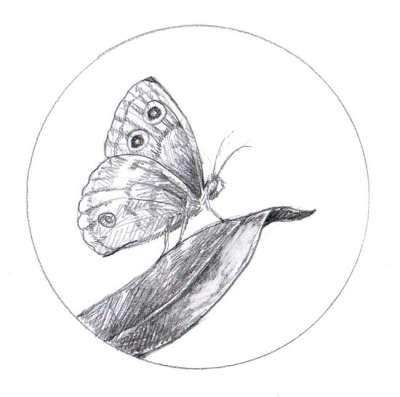
By mid-July, the oregano in my herb garden has grown tall and tatty, and I want nothing more than to cut it back into a tidy mound. But I don’t. Doing so would deprive the flurry of common wood nymph butterflies that swarm the plants every year. The messiness is a small price to pay for the sight of them flitting around en masse.
I have learned to expect their arrival, having witnessed it every summer, since I planted gardens around my home six years ago. At first, just one or two appear, but within days there are dozens. Soon, the oregano’s purple flowers are covered in butterflies. But this brief visit is only a part of the story of the common wood nymph butterfly (Cercyonis pegala). What are they doing for the other eleven and a half months of the year?
Not much, it turns out. At least, not at first.
The females lay eggs in late summer or early autumn on a host plant, often purpletop tridens – a common field grass with purple spikes and sticky upper stems. The caterpillars emerge before the first frost. Unlike other caterpillars that feast upon hatching, wood nymphs don’t eat a single thing until spring. Their first order of business is to burrow into a clump grass where they wait out the long winter months.
How butterflies overwinter varies from species to species, explained Kent McFarland, a conservation biologist with the Vermont Center for Ecostudies. Monarchs, for example, migrate to warmer climes; other adult butterflies, such as the mourning cloak, survive the New England winters by crawling beneath tree bark and entering a stage called diapause, in which their metabolic and respiratory rates slow down. Sometimes species only exist as eggs in the winter. Still others become pupae and emerge as butterflies in the spring. McFarland said that overwintering in the caterpillar stage, as the wood nymph butterfly does, is not unusual.
In late spring, the lengthening days and warmer temperatures signal the wood nymph caterpillars to end their hibernation. Having spent their whole lives without a single meal, they emerge ready to pack on the weight. They feed mostly at night, which helps them to avoid predation. Within a few weeks, they form a chrysalis and metamorphose into butterflies by mid-summer.
Common wood nymph butterflies are brown, with two ringed eyespots on the upper wings. The lower wings also have eyespots that are smaller and vary in number. Their range is vast, from southern Canada to most of the continental United States.
Compared to monarchs or black swallowtails, they aren’t particularly stunning. When they first few arrived some years ago, I hardly noticed them. But then more came. And then more still.
Walking through my garden at the peak of their visit is like stepping into a fairy tale. One common wood nymph butterfly may not be stunning, but dozens of them at once is magical.
By mid-August, they die. According to McFarland, the adults live only a few weeks to a month at best.
I wait until the last few stragglers disappear, before taking the cutting shears to the oregano. The herb garden looks neater, but no longer magical. Next July, it will again grow floppy and messy, and I will know that the wood nymphs are on their way.

